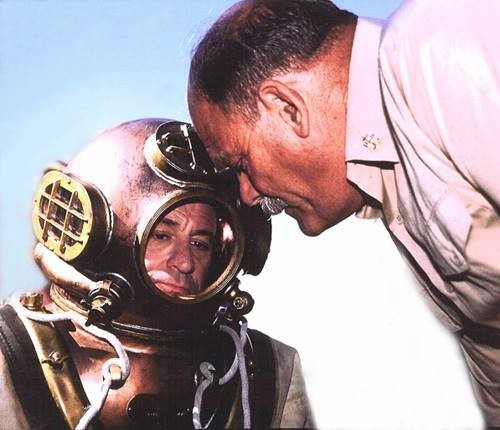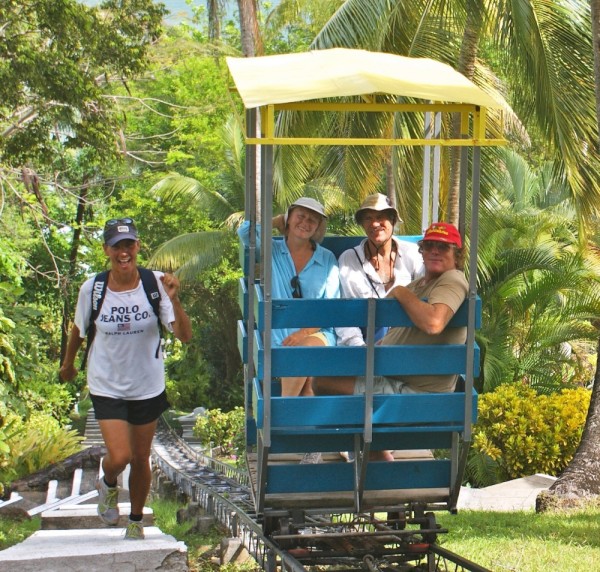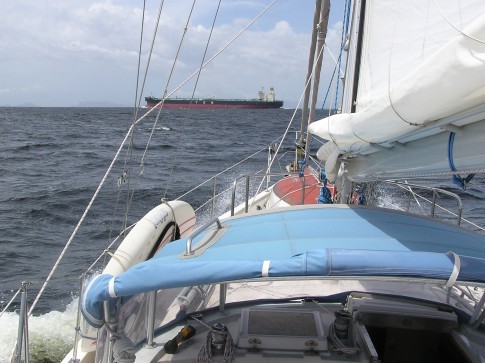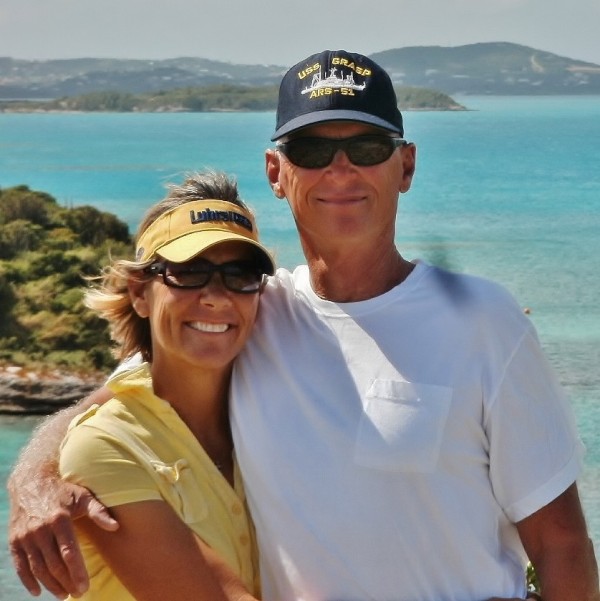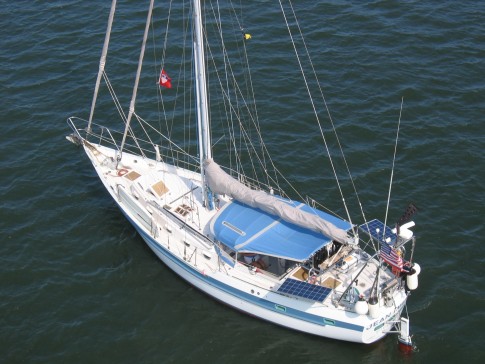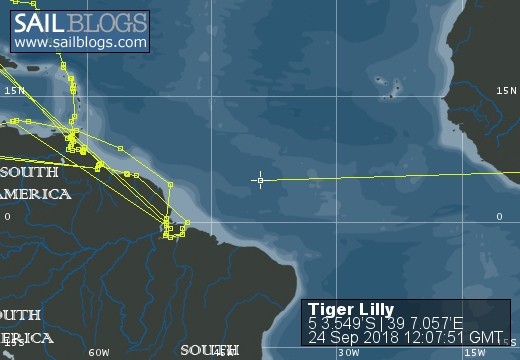
S/V Tiger Lilly
Rig heavy, reef early, and pray often; for God does not assure us an easy passage, but He does promise a safe anchorage...
25 May 2018 | TRINCOMALEE, SRI LANKA
02 January 2018 | Clan Jeti Anchorage, Georgetown, Penang Island, Malaysia
03 November 2016 | Singapore, Southeast Asia
02 October 2016 | Kumai River, Borneo
24 August 2016 | Rindja Island, Indonesia
22 July 2016 | Fannie Bay, Darwin, Northern Territory, Australia
14 June 2016 | Pancake Creek, Queensland, Australia
13 June 2016 | Pancake Creek, Queensland, Australia
11 June 2016 | Burnette Heads, Queensland, Australia
07 June 2016 | Mooloolaba, Queensland, Australia
11 May 2016 | Colmsie, Brisbane River, Queensland, Australia
23 December 2015 | Brisbane, Australia
13 August 2015 | Whangarei, New Zealand
07 August 2015 | Whangarei, New Zealand
23 July 2015 | Whangarei, New Zealand
12 April 2015 | Whangarei, New Zealand
11 February 2015 | Whangarei, New Zealand
25 January 2015 | Whangarei, New Zealand
24 September 2014 | BORA BORA, French Polynesia
23 September 2014 | Bora Bora
TIGER LILLY - THE DOCKYARD AT ENGLISH HARBOUR
17 March 2012 | Antigua, West Indies
Desmond Nicholson
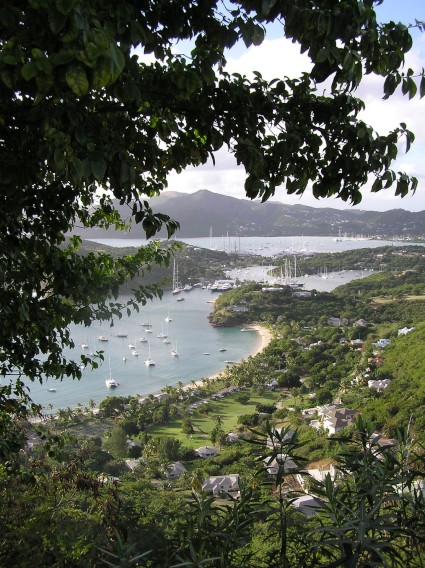
During its heyday in the Eighteenth Century, English Harbour was the home of the Royal Navy's West Indian Squadron, commanded by none other than Commodore Nelson - the hero of the British Navy. The Dockyard provided repair services to the Royal Navy ships watching the French on the nearby island of Guadeloupe, and a safe haven during hurricanes. But in 1949 when the Nicholson family arrived aboard their schooner Mollihawk, English Harbour was the site of a dilapidated and abandoned Royal Naval Dockyard. Today, Antigua's English Harbour is the center of a thriving international yacht charter business, with the largest sailing yachts in the world basing their winter operations out of this secure and scenic natural harbour. Although many people participated in this metamorphosis, Commander V.E.B. Nicholson and his family were the driving force responsible for the transformation of English Harbour into what we see today. Below are paraphrased excerpts from the memoir of Commander Nicholson's son, the late Captain Desmond Nicholson, a member of the West Indies First Family of Yachting which was instrumental in creating Antigua's Nelson's Dockyard National Park:
WEST INDIES YACHTING - AN EARLY HISTORY
I am Desmond Vernon Nicholson, the son of Commander V.E.B. Nicholson, Royal Navy (retired). Our family arrived in Antigua in 1949 from Ireland and England aboard our schooner Mollihawk.
During the early years of World War II father had served aboard the HMS Diomede which had called at the Royal Naval Dockyard in English Harbour, Antigua. He was captured by the beauty of the West Indies, had seen what a fine cruising ground the area was, and became interested in the business opportunities the then English Colony presented. Later in the War, he was helping to search for rivers and estuaries of Devon and Cornwall as suitable places to gather landing craft for the invasion of Europe in 1944. On the River Dart, Devon, he saw a fine schooner yacht called the 'Mollihawk", so he decided to purchase her, especially since it was wartime and the price was really cheap. So on February 8, 1949, after a voyage of some eight weeks, mother, father and two sons, Desmond and Rodney anchored off the Pelican Rocks in St. John's Harbour. The few other vessels in the harbour at the time were sailing fishing sloops and inter-island trading schooners. Steamships then anchored outside the harbour and hefty sailing barges unloaded the ships. I remember these cumbersome vessels being handled very skillfully under sail.
About a week after we arrived in St. Johns, we sailed Mollihawk round to Nelsons Dockyard in English Harbour and came alongside the north wharf next to the Cordage, Canvas and Clothing Store that still possessed a part of the upper floor, but with a collapsed roof. The Mollihawk was due for maintenance, so the family moved into the abandoned Officer's Quarters. Some of the yacht visitors at the dockyard at that time were the 'Sea Gypsy' of New York and the famous Brigantine 'Yankee'. On March 26th 1949, while Yankee was entering English Harbour there was a loud steel band playing. It was a picnic of the "Red Army" steel band celebrating the return of the Governor Lord Baldwin who had been called back to England. He had been reprimanded for ignoring the plantocracy and favouring the black Antiguans at Government House. A black gentleman was dancing around the Dockyard with a banner "Baldwin on the Carpet, but Dancing a Waltz!" In those days, steel bands, especially the "Red Army", were used as weapons against the planter class by the Antigua Trades and Labour Union (AT&LU) to show a fighting spirit for the better. They had been encouraged and trained by Lord Baldwin himself. After this public function at the Dockyard, it was decided that the remains of the upper floor of the Cordage Store should be taken down as they were too dangerous, so the upper walls were dismantled by the Public Works Department. The other ruins of the Dockyard were still standing, but dilapidated. Shingles lay around the yard, shutters banged and goats roamed keeping the grass well cut.
When our family arrived in Antigua we thought it was a nice West Indian island - and so it was... But compared with today, it was just amazing! Leeward Island sloops and West Indian schooners plied between the islands with cargoes, and sometimes smuggled rum and cigarettes from St. Barts. Fishing sloops ran out of English Harbour to South Bank about 15 miles south-east of the Harbour and they were repaired and careened at the Dockyard. There was Mr. Gilbert's "Lady Faith" and Mr. Sebastian's "Nellie", both carvels of sloops. Their booms were very long, extending way aft to give a push to windward. The mast and booms were of the same length as the hull, an overlapping jib gave these little native craft speed, and the high bow kept the deck sitting helmsman dry. Musical entertainment was given us in the Dockyard by a fife band consisting of Jeffrey Sebastian and Basil Potter. Their favorite tune seemed to be "Sly Mongoose" and "Don't Walk dere, you Catch de Big Foot!" At English Harbour Village there was just one car, a taxi owned by the only grocer, Mr. Allistan West who was cross-eyed. He wrapped up your purchases in a page torn out of a large bound volume of the "The Illustrated London News". Two special characters of English Harbour of this time were 'Tarzan' Tercheira and 'Samjo'. Tarzan was a fisherman and lived in a hut where the Dry Dock Restaurant is today. He was a bit of a smuggler and one day the Police caught up with him. He escaped by swimming clear across Falmouth Harbour. Samjo was a vagrant and a grave digger of no fixed address, putting his head down anywhere in the village. Oxen ploughed the fields in preparation for sugar planting and Antiguans cut cane by hand for a pittance, rather like the days of slavery. The Central Sugar Factory worked in full swing, except when there were strikes. As I said, there were no cars, so people just walked everywhere. Ladies balanced their baskets and bags on their heads. Some, when walking to town, took their shoes off for comfort, and to be smartly dressed, would, on arrival, simply put them on again. Letters to the Post Office were even carried on the head with a stone placed on top, to stop them blowing off. In Bryson's grocery store, when, for example, a pound of butter was requested, an old man with a long beard would shuffle off and fetch it from a kerosene running refrigerator. Some Antiguan Expressions heard at English Harbour, 1950's:
Please, sir, I want something to keep my hands amused (a job).
I have a shilling in hiding to have a pant built.
Boo Hoo, my bladder's leaking! (My balloon has burst)
Nothing but naked sea (no land in sight).
I can tell it's him coming by the way he throws his foot!
Nothing but naked guesses (so many guests).
I hardly missed your back before I saw your face again!
Naked rum (with no water in it).
Where is he? I heard his voice speaking to the east, Madam!
A tom cat was a "Ram Pussy".
THE BEGINNINGS OF YACHT CHARTERING
During the first refit after crossing the Atlantic, we had lived in a couple of rooms at the east end of the Officer's Quarters, next to the "Hold me Tight Room", the floor of which had collapsed in 1947, while a dance was being held there. It happened to the tune of "Hold me Tight Honey!" hence the current name of the room. Then after the short stay at Hodge's Bay, we moved back to the Dockyard and lived in the Pay Office, but before we could do that my brother and I picked up the wooded shingles scattered around and patched up the roof. We possessed a kerosene refrigerator. They were very messy to run, the sooty chimney often had to be cleaned out with a special long brush, and we became covered with soot in the process. Occasionally, to keep the fridge really cold, the whole thing had to be turned upside down until it stopped bubbling and gurgling! However, it was refreshing to have cold water to drink. We stored water in used rum bottles in which we also stored our kerosene. Once we offered guests some cold water, and guess what - they took a sip of kerosene instead! The Mill Reef Club had officially opened the same month, February 1949, as the 'Mollihawk' had arrived. The members often visited the Dockyard and saw this fine yacht and dreamed of cruising aboard her. Then one day a member, Mr. John Archbold, who owned Springfield Plantation in Dominica, wanted a passage to his estate. So in April 1949, father, brother Rodney and I, sailed Mr. Archbold to Roseau and left Mother and Uncle Victor behind in the old Pay Office. The trip to Dominica was the first time we had ever made an income chartering our vessel, though this was not a true charter party.
TRINIDAD: TO ESCAPE HURRICANES
As the hurricane season approached we thought it prudent to travel south to Trinidad which is supposedly out of hurricane alley. Those were the days before regular weather forecasts, so in July 1949, we sailed south to the Trinidad Yacht Club. There we met Clement Mark, who was a waiter at the Club, and took him on as Mollihawk's cook. He was much later to become a restaurateur over Laurent's Drug Store near the market at St. John's. Our other crew member, Edmund James, was from Grenada. These two gentlemen served wonderfully during the main charter period that was to come. Warneford Sebastian from Mast Pond, English Harbour was yet another very fine charter crew, as was Kenneth Potter.
A RARE VISIT
December 1949, we had a most amazing visit at the Dockyard. It was a 36' Spanish sailing fishing boat laden with 56 refugees from Franco's Spain. They had sailed from the Canary Islands, 3,000 miles over the Atlantic and they supposed that they had reached Venezuela, their intended destination. They had run out of food and water for four days and they had ended up off Mill Reef. Ralph Camacho in his motor boat 'Saucy Sue' found them and guided them into English Harbour. There were persons of all walks of life, male and female, one of which was pregnant and gave birth amongst the goat droppings of the Pay Office. They danced with a guitar and castanets and had a merry time in celebration of their arrival. I will never forget the English Harbour villagers coming down to the Dockyard with fruits and vegetables on their heads with their offerings to the people of the sea. Antiguans who had worked in Santo Domingo were in their element speaking Spanish. The Syrians and Lebanese came out from town in their Oldsmobiles donating materials and clothes from their dry goods stores. A yachtsman gave charts and tutored the boat's Captain on how to reach Venezuela, "Count the islands down and then turn right!" We actually heard from one of them later, they had found jobs and all were happy.
THE FIRST REAL CHARTER
The Mollihawk had taken a few other day sails and passages to Guadeloupe by Mill Reef members and full recommendations were given to their friends back home in the States. This led to the first true and proper charter of Mollihawk taking place on January 30 1950, and was a party from Chicago, the William Erharts and the George Browns of Chicago. A full season of 12 weeks followed.
CAUGHT IN HURRICANES
At the end of that second Hurricane Season, we survived two hurricanes at the Dockyard, one was on 21st August 1950, which gave 100 mph winds, and the other was ten days later which blew at 145 mph. The barometer dropped to 29.02 of mercury. 1,348 houses were destroyed and 2,343 were damaged. 6,792 people became homeless which was 15% of the population. During the hurricanes the 'Mollihawk' was moored alongside the small wharf by the Seaman's Galley and old rotting timbers from the buildings were used as fenders. Lead roof capping was flying around as well as many shingles and I remember some of the siding on the north side of the Pay Office came off and I saw the Mollihawk framed in vivid flashes of lightning. Next day villagers, whose houses were destroyed, took over the Officer's Quarters and other buildings in the Dockyard were used by refugees. The new Governor, Mr. Kenneth W. Blackburne, inspected the hurricane damage in the villages. At the Dockyard he met and talked to the hurricane refugees. The old Royal Navy buildings already were in the last stages of decay before the hurricane decimated English Harbour.
"But there was one small ray of hope amid the despair of the island. Alongside the ole stone wharves lay a beautiful schooner yacht, whose owner had settled in the one habitable building in the Dockyard and was using it as a base for charters. And so an idea was born.... Why should the old buildings not be used again for sailing ships - though for yachts rather than men-o'-war? Why should the Dockyard not become a memorial to the great deeds of the Royal Navy in the wars of the 18th century? And why should it not become a tourist resort?" (Sir Kenneth Blackburne in "Corona", a colonial magazine.)
THE DOCKYARD TO BE RESTORED
In 1951, the Governor of the Leeward Islands, Sir Kenneth Blackburne, launched the Society of Friends of English Harbour, the aims of which were to restore the old buildings and to encourage yachting by providing suitable facilities. My father, Commander V.E.B. Nicholson Royal Navy (retired), became the first restoration supervisor and Mr. Oliver Knowles, of New Winthrop's Village carried out the technical work.
HARD TIMES IN ANTIGUA
My mother was very, very good to the local children, offering food to the hungrier and poorer ones, as times were difficult for the people due to strikes by the sugar workers as their wages were so low. When we expanded our charter fleet and when cruising yachts started visiting English Harbour, my mother would try to find employment for the people of English Harbour. Mostly this would be in the capacity of scraping and scrubbing up and cleaning down below. One yachtsman, Edward Allcard of Sea Wanderer, raised his eyebrows when my mother one day asked, "Edward, I hear you want a girl!" For 60 cents / day, Edward was able to get on with more technicalities than just being a housekeeper! Now 50 years later, my mother's kindness in those formative days of the Dockyard's recent history is still remembered. The Red Cross gave a posthumous award to her in 1997, twenty-one years after her death!
YACHT MAINTENANCE AT ENGLISH HARBOUR
Now I must tell you about a wonderful and much needed character of English Harbour in the early years. A brilliant engineer was Mr. Dennis Gabriel of Cherry Hill Estate above Blake Island in Falmouth Harbour. Self taught, he was remarkable, because he could fix anything. He was a thin, balding man of about 55, always dressed in Khaki pants way too big for him, suspended with home-made braces of inner tube. Large Mrs. Florence Gabriel, always dressed in colourful calico, was a remarkable lady in her own way; she always accompanied Dennis whenever demanded at the Dockyard for yacht repairs. She often whiled away her time on a folding stool, painting water colours of the historic buildings until her husband had finished his job. There were no spare parts available for yacht maintenance in those days, so when a engine rocker arm of the yacht "Fedoa" broke just before David Rockefeller chartered her, Dennis and the carpenter, Frederick Gilbert, contributed a substitute made of lignum vitae, a very hard wood used for, amongst many other things, courtroom gavels, bowling balls, stern tubes and the plant itself was used for tonics, gargle, gout and syphilis. Two of these trees now grow on the north side of the Pay Office in the Dockyard, but they are yet young and small. The Rockefeller charter worked out just fine and later it was a delight to observe the mechanic's face from St. John's when removing the valve cover to discover a semi-wooden engine! (Rockefeller never knew!). Mr. Gabriel's old car was held together with bailing wire, and the instruments swung by wires below their holds in the dashboard. Lift the bonnet, you would find the engine and a bowl of dirty water. Under the seat was an enormous collection of tools and on the seat would be a young goat or two, complete with fodder. On the roof sat his large dog even when riding down the hole-ridden road through English Harbour Village. Mr. Gabriel believed in sump oil and molasses as a panacea and dug a pit outside the Galley in which sump oil settled. Once he fell in, but nobody laughed, he was so well respected and needed!
Frederick Gilbert of English Harbour was the Dockyard Caretaker in the early years from 1941. He was a carpenter and later became a fine shipwright. When we damaged the bowsprit of the 'Mollihawk' in the Grenadines during the Christmas winds one year, we flew him there to fix it and well did he! When there was no work to be done on the yachts, we had him build an 18 ft. sailing dinghy that we called 'Mollibooby'. He had it set up in the boat shed under the Joiner's Loft and we were always amused when he marked the port and starboard ribs and the other parts as east and west!
For major underwater repairs the 'Mollihawk' had to sail to Barbados to be lifted on the old steam screw dock at the Bridgetown Careenage. For minor underwater repairs, we were given a divine helmet by a charterer, Mr. Felix Williams, who was the President of the Monsanto Chemical Company. With this we were able to scrub the ship's bottom and even remove the propeller, when necessary. The nickname for this helmet was "Old Man Mose", and is still to be seen in the Dockyard Museum.
At the Dockyard, we carried out the tricky job of removing the mast of the 'Mollihawk' for repairs and at another time, we even installed a new engine. My father's fuel for the manpower at this time was "two cases of rum and a hundred men and we'll get 'Mollihawk's' spar back in!" To build a derrick for these purposes, we called upon the Antigua Sugar Factory to lend us the necessary equipment. The factory also possessed a well stocked store room and a superb machine shop, these were well used by us.
THE NICHOLSON FAMILY BUSINESS
At first my father was in command of the 'Mollihawk', taking one of his sons as Mate. Then the day came when the two sons took the vessel on their own. Later, just one of the sons took command of the 'Mollihawk' with a West Indian crew. The other son skippered one of the other yachts in our care. Commander and Mrs. Nicholson stayed back in the Pay Office where they looked after the charter reservations and accounts. Rodney had a good background of radio technology, so was responsible for communications. we ordered two army surplus B-19 radio transceivers to keep in contact with our headquarters, the Pay Office. The dials of the radio were marked in Russian as they had been manufactured for "Aid to Russia" during the war. As a hobby, Rodney obtained an amateur radio license (VP2AJ). Our good friend and fellow amateur was Jim Browne, who worked at a lumber and hardware store on Redcliffe Street. In the off season, while living in the Pay Office, we contacted amateur radio stations around the world on 15 metres with a galvanized wire antenna slung across the Dockyard between the masts of two yachts, using cockleshells as insulators! The radio was also useful for keeping watch on the weather. My hobby was photography, so I set up a darkroom in the Pay Office and began producing yacht charter advertising material. I took photos of the yachts and made brochures, using specially ordered Ilford photographic materials from England. I washed the prints in a large wooden orange crate floating in the sea. This saved fresh water, which was very scarce; the prints only needed a short pass through fresh water to eliminate the salt. We had a black and white general yacht cruising brochure printed. The opening words were classic (corny):
"Relax and let yourself be wafted with white billowing canvas aloft and crystal clear waters below, to the tropical islands of your fancy!"
It must have worked, as we soon had many potential clients writing for details or to make bookings, though word of mouth recommendations were foremost. We advertised in 'Yachting Magazine', 'The Saturday Review of Literature' and three times in 'Holiday Magazine'. In 1959 we received 381 enquiries - mostly in January of 1954. Our ad read:
CRUISE ABOARD your own yacht in the Caribbean.
Refreshing summer trade winds, cool and calm.
Cruising ground between Antigua and Grenada.
Luxurious, fully crewed ships.
Write airmail, Commander Nicholson
Box 103, Antigua, West Indies
Rodney married Julie Pyle whom had circumnavigated the world on the brigantine 'Yankee' and she joined the office from 1956. I married Lisa Dodd, one of my charterer's daughters, in 1957 after I had been in command of the yacht "Freelance". However, from then on, I gave up my profession as a sea captain.
So now I have related how the Nicholson's arrived in Antigua, what the island was like fifty years ago and how the charter firm of VEB Nicholson & Sons started its operations at Nelson's Dockyard, which eventually became a new industry for Antigua.
(Desmond Nicholson passed away in his beloved Antigua at the age of 80...)
WEST INDIES YACHTING - AN EARLY HISTORY
I am Desmond Vernon Nicholson, the son of Commander V.E.B. Nicholson, Royal Navy (retired). Our family arrived in Antigua in 1949 from Ireland and England aboard our schooner Mollihawk.
During the early years of World War II father had served aboard the HMS Diomede which had called at the Royal Naval Dockyard in English Harbour, Antigua. He was captured by the beauty of the West Indies, had seen what a fine cruising ground the area was, and became interested in the business opportunities the then English Colony presented. Later in the War, he was helping to search for rivers and estuaries of Devon and Cornwall as suitable places to gather landing craft for the invasion of Europe in 1944. On the River Dart, Devon, he saw a fine schooner yacht called the 'Mollihawk", so he decided to purchase her, especially since it was wartime and the price was really cheap. So on February 8, 1949, after a voyage of some eight weeks, mother, father and two sons, Desmond and Rodney anchored off the Pelican Rocks in St. John's Harbour. The few other vessels in the harbour at the time were sailing fishing sloops and inter-island trading schooners. Steamships then anchored outside the harbour and hefty sailing barges unloaded the ships. I remember these cumbersome vessels being handled very skillfully under sail.
About a week after we arrived in St. Johns, we sailed Mollihawk round to Nelsons Dockyard in English Harbour and came alongside the north wharf next to the Cordage, Canvas and Clothing Store that still possessed a part of the upper floor, but with a collapsed roof. The Mollihawk was due for maintenance, so the family moved into the abandoned Officer's Quarters. Some of the yacht visitors at the dockyard at that time were the 'Sea Gypsy' of New York and the famous Brigantine 'Yankee'. On March 26th 1949, while Yankee was entering English Harbour there was a loud steel band playing. It was a picnic of the "Red Army" steel band celebrating the return of the Governor Lord Baldwin who had been called back to England. He had been reprimanded for ignoring the plantocracy and favouring the black Antiguans at Government House. A black gentleman was dancing around the Dockyard with a banner "Baldwin on the Carpet, but Dancing a Waltz!" In those days, steel bands, especially the "Red Army", were used as weapons against the planter class by the Antigua Trades and Labour Union (AT&LU) to show a fighting spirit for the better. They had been encouraged and trained by Lord Baldwin himself. After this public function at the Dockyard, it was decided that the remains of the upper floor of the Cordage Store should be taken down as they were too dangerous, so the upper walls were dismantled by the Public Works Department. The other ruins of the Dockyard were still standing, but dilapidated. Shingles lay around the yard, shutters banged and goats roamed keeping the grass well cut.
When our family arrived in Antigua we thought it was a nice West Indian island - and so it was... But compared with today, it was just amazing! Leeward Island sloops and West Indian schooners plied between the islands with cargoes, and sometimes smuggled rum and cigarettes from St. Barts. Fishing sloops ran out of English Harbour to South Bank about 15 miles south-east of the Harbour and they were repaired and careened at the Dockyard. There was Mr. Gilbert's "Lady Faith" and Mr. Sebastian's "Nellie", both carvels of sloops. Their booms were very long, extending way aft to give a push to windward. The mast and booms were of the same length as the hull, an overlapping jib gave these little native craft speed, and the high bow kept the deck sitting helmsman dry. Musical entertainment was given us in the Dockyard by a fife band consisting of Jeffrey Sebastian and Basil Potter. Their favorite tune seemed to be "Sly Mongoose" and "Don't Walk dere, you Catch de Big Foot!" At English Harbour Village there was just one car, a taxi owned by the only grocer, Mr. Allistan West who was cross-eyed. He wrapped up your purchases in a page torn out of a large bound volume of the "The Illustrated London News". Two special characters of English Harbour of this time were 'Tarzan' Tercheira and 'Samjo'. Tarzan was a fisherman and lived in a hut where the Dry Dock Restaurant is today. He was a bit of a smuggler and one day the Police caught up with him. He escaped by swimming clear across Falmouth Harbour. Samjo was a vagrant and a grave digger of no fixed address, putting his head down anywhere in the village. Oxen ploughed the fields in preparation for sugar planting and Antiguans cut cane by hand for a pittance, rather like the days of slavery. The Central Sugar Factory worked in full swing, except when there were strikes. As I said, there were no cars, so people just walked everywhere. Ladies balanced their baskets and bags on their heads. Some, when walking to town, took their shoes off for comfort, and to be smartly dressed, would, on arrival, simply put them on again. Letters to the Post Office were even carried on the head with a stone placed on top, to stop them blowing off. In Bryson's grocery store, when, for example, a pound of butter was requested, an old man with a long beard would shuffle off and fetch it from a kerosene running refrigerator. Some Antiguan Expressions heard at English Harbour, 1950's:
Please, sir, I want something to keep my hands amused (a job).
I have a shilling in hiding to have a pant built.
Boo Hoo, my bladder's leaking! (My balloon has burst)
Nothing but naked sea (no land in sight).
I can tell it's him coming by the way he throws his foot!
Nothing but naked guesses (so many guests).
I hardly missed your back before I saw your face again!
Naked rum (with no water in it).
Where is he? I heard his voice speaking to the east, Madam!
A tom cat was a "Ram Pussy".
THE BEGINNINGS OF YACHT CHARTERING
During the first refit after crossing the Atlantic, we had lived in a couple of rooms at the east end of the Officer's Quarters, next to the "Hold me Tight Room", the floor of which had collapsed in 1947, while a dance was being held there. It happened to the tune of "Hold me Tight Honey!" hence the current name of the room. Then after the short stay at Hodge's Bay, we moved back to the Dockyard and lived in the Pay Office, but before we could do that my brother and I picked up the wooded shingles scattered around and patched up the roof. We possessed a kerosene refrigerator. They were very messy to run, the sooty chimney often had to be cleaned out with a special long brush, and we became covered with soot in the process. Occasionally, to keep the fridge really cold, the whole thing had to be turned upside down until it stopped bubbling and gurgling! However, it was refreshing to have cold water to drink. We stored water in used rum bottles in which we also stored our kerosene. Once we offered guests some cold water, and guess what - they took a sip of kerosene instead! The Mill Reef Club had officially opened the same month, February 1949, as the 'Mollihawk' had arrived. The members often visited the Dockyard and saw this fine yacht and dreamed of cruising aboard her. Then one day a member, Mr. John Archbold, who owned Springfield Plantation in Dominica, wanted a passage to his estate. So in April 1949, father, brother Rodney and I, sailed Mr. Archbold to Roseau and left Mother and Uncle Victor behind in the old Pay Office. The trip to Dominica was the first time we had ever made an income chartering our vessel, though this was not a true charter party.
TRINIDAD: TO ESCAPE HURRICANES
As the hurricane season approached we thought it prudent to travel south to Trinidad which is supposedly out of hurricane alley. Those were the days before regular weather forecasts, so in July 1949, we sailed south to the Trinidad Yacht Club. There we met Clement Mark, who was a waiter at the Club, and took him on as Mollihawk's cook. He was much later to become a restaurateur over Laurent's Drug Store near the market at St. John's. Our other crew member, Edmund James, was from Grenada. These two gentlemen served wonderfully during the main charter period that was to come. Warneford Sebastian from Mast Pond, English Harbour was yet another very fine charter crew, as was Kenneth Potter.
A RARE VISIT
December 1949, we had a most amazing visit at the Dockyard. It was a 36' Spanish sailing fishing boat laden with 56 refugees from Franco's Spain. They had sailed from the Canary Islands, 3,000 miles over the Atlantic and they supposed that they had reached Venezuela, their intended destination. They had run out of food and water for four days and they had ended up off Mill Reef. Ralph Camacho in his motor boat 'Saucy Sue' found them and guided them into English Harbour. There were persons of all walks of life, male and female, one of which was pregnant and gave birth amongst the goat droppings of the Pay Office. They danced with a guitar and castanets and had a merry time in celebration of their arrival. I will never forget the English Harbour villagers coming down to the Dockyard with fruits and vegetables on their heads with their offerings to the people of the sea. Antiguans who had worked in Santo Domingo were in their element speaking Spanish. The Syrians and Lebanese came out from town in their Oldsmobiles donating materials and clothes from their dry goods stores. A yachtsman gave charts and tutored the boat's Captain on how to reach Venezuela, "Count the islands down and then turn right!" We actually heard from one of them later, they had found jobs and all were happy.
THE FIRST REAL CHARTER
The Mollihawk had taken a few other day sails and passages to Guadeloupe by Mill Reef members and full recommendations were given to their friends back home in the States. This led to the first true and proper charter of Mollihawk taking place on January 30 1950, and was a party from Chicago, the William Erharts and the George Browns of Chicago. A full season of 12 weeks followed.
CAUGHT IN HURRICANES
At the end of that second Hurricane Season, we survived two hurricanes at the Dockyard, one was on 21st August 1950, which gave 100 mph winds, and the other was ten days later which blew at 145 mph. The barometer dropped to 29.02 of mercury. 1,348 houses were destroyed and 2,343 were damaged. 6,792 people became homeless which was 15% of the population. During the hurricanes the 'Mollihawk' was moored alongside the small wharf by the Seaman's Galley and old rotting timbers from the buildings were used as fenders. Lead roof capping was flying around as well as many shingles and I remember some of the siding on the north side of the Pay Office came off and I saw the Mollihawk framed in vivid flashes of lightning. Next day villagers, whose houses were destroyed, took over the Officer's Quarters and other buildings in the Dockyard were used by refugees. The new Governor, Mr. Kenneth W. Blackburne, inspected the hurricane damage in the villages. At the Dockyard he met and talked to the hurricane refugees. The old Royal Navy buildings already were in the last stages of decay before the hurricane decimated English Harbour.
"But there was one small ray of hope amid the despair of the island. Alongside the ole stone wharves lay a beautiful schooner yacht, whose owner had settled in the one habitable building in the Dockyard and was using it as a base for charters. And so an idea was born.... Why should the old buildings not be used again for sailing ships - though for yachts rather than men-o'-war? Why should the Dockyard not become a memorial to the great deeds of the Royal Navy in the wars of the 18th century? And why should it not become a tourist resort?" (Sir Kenneth Blackburne in "Corona", a colonial magazine.)
THE DOCKYARD TO BE RESTORED
In 1951, the Governor of the Leeward Islands, Sir Kenneth Blackburne, launched the Society of Friends of English Harbour, the aims of which were to restore the old buildings and to encourage yachting by providing suitable facilities. My father, Commander V.E.B. Nicholson Royal Navy (retired), became the first restoration supervisor and Mr. Oliver Knowles, of New Winthrop's Village carried out the technical work.
HARD TIMES IN ANTIGUA
My mother was very, very good to the local children, offering food to the hungrier and poorer ones, as times were difficult for the people due to strikes by the sugar workers as their wages were so low. When we expanded our charter fleet and when cruising yachts started visiting English Harbour, my mother would try to find employment for the people of English Harbour. Mostly this would be in the capacity of scraping and scrubbing up and cleaning down below. One yachtsman, Edward Allcard of Sea Wanderer, raised his eyebrows when my mother one day asked, "Edward, I hear you want a girl!" For 60 cents / day, Edward was able to get on with more technicalities than just being a housekeeper! Now 50 years later, my mother's kindness in those formative days of the Dockyard's recent history is still remembered. The Red Cross gave a posthumous award to her in 1997, twenty-one years after her death!
YACHT MAINTENANCE AT ENGLISH HARBOUR
Now I must tell you about a wonderful and much needed character of English Harbour in the early years. A brilliant engineer was Mr. Dennis Gabriel of Cherry Hill Estate above Blake Island in Falmouth Harbour. Self taught, he was remarkable, because he could fix anything. He was a thin, balding man of about 55, always dressed in Khaki pants way too big for him, suspended with home-made braces of inner tube. Large Mrs. Florence Gabriel, always dressed in colourful calico, was a remarkable lady in her own way; she always accompanied Dennis whenever demanded at the Dockyard for yacht repairs. She often whiled away her time on a folding stool, painting water colours of the historic buildings until her husband had finished his job. There were no spare parts available for yacht maintenance in those days, so when a engine rocker arm of the yacht "Fedoa" broke just before David Rockefeller chartered her, Dennis and the carpenter, Frederick Gilbert, contributed a substitute made of lignum vitae, a very hard wood used for, amongst many other things, courtroom gavels, bowling balls, stern tubes and the plant itself was used for tonics, gargle, gout and syphilis. Two of these trees now grow on the north side of the Pay Office in the Dockyard, but they are yet young and small. The Rockefeller charter worked out just fine and later it was a delight to observe the mechanic's face from St. John's when removing the valve cover to discover a semi-wooden engine! (Rockefeller never knew!). Mr. Gabriel's old car was held together with bailing wire, and the instruments swung by wires below their holds in the dashboard. Lift the bonnet, you would find the engine and a bowl of dirty water. Under the seat was an enormous collection of tools and on the seat would be a young goat or two, complete with fodder. On the roof sat his large dog even when riding down the hole-ridden road through English Harbour Village. Mr. Gabriel believed in sump oil and molasses as a panacea and dug a pit outside the Galley in which sump oil settled. Once he fell in, but nobody laughed, he was so well respected and needed!
Frederick Gilbert of English Harbour was the Dockyard Caretaker in the early years from 1941. He was a carpenter and later became a fine shipwright. When we damaged the bowsprit of the 'Mollihawk' in the Grenadines during the Christmas winds one year, we flew him there to fix it and well did he! When there was no work to be done on the yachts, we had him build an 18 ft. sailing dinghy that we called 'Mollibooby'. He had it set up in the boat shed under the Joiner's Loft and we were always amused when he marked the port and starboard ribs and the other parts as east and west!
For major underwater repairs the 'Mollihawk' had to sail to Barbados to be lifted on the old steam screw dock at the Bridgetown Careenage. For minor underwater repairs, we were given a divine helmet by a charterer, Mr. Felix Williams, who was the President of the Monsanto Chemical Company. With this we were able to scrub the ship's bottom and even remove the propeller, when necessary. The nickname for this helmet was "Old Man Mose", and is still to be seen in the Dockyard Museum.
At the Dockyard, we carried out the tricky job of removing the mast of the 'Mollihawk' for repairs and at another time, we even installed a new engine. My father's fuel for the manpower at this time was "two cases of rum and a hundred men and we'll get 'Mollihawk's' spar back in!" To build a derrick for these purposes, we called upon the Antigua Sugar Factory to lend us the necessary equipment. The factory also possessed a well stocked store room and a superb machine shop, these were well used by us.
THE NICHOLSON FAMILY BUSINESS
At first my father was in command of the 'Mollihawk', taking one of his sons as Mate. Then the day came when the two sons took the vessel on their own. Later, just one of the sons took command of the 'Mollihawk' with a West Indian crew. The other son skippered one of the other yachts in our care. Commander and Mrs. Nicholson stayed back in the Pay Office where they looked after the charter reservations and accounts. Rodney had a good background of radio technology, so was responsible for communications. we ordered two army surplus B-19 radio transceivers to keep in contact with our headquarters, the Pay Office. The dials of the radio were marked in Russian as they had been manufactured for "Aid to Russia" during the war. As a hobby, Rodney obtained an amateur radio license (VP2AJ). Our good friend and fellow amateur was Jim Browne, who worked at a lumber and hardware store on Redcliffe Street. In the off season, while living in the Pay Office, we contacted amateur radio stations around the world on 15 metres with a galvanized wire antenna slung across the Dockyard between the masts of two yachts, using cockleshells as insulators! The radio was also useful for keeping watch on the weather. My hobby was photography, so I set up a darkroom in the Pay Office and began producing yacht charter advertising material. I took photos of the yachts and made brochures, using specially ordered Ilford photographic materials from England. I washed the prints in a large wooden orange crate floating in the sea. This saved fresh water, which was very scarce; the prints only needed a short pass through fresh water to eliminate the salt. We had a black and white general yacht cruising brochure printed. The opening words were classic (corny):
"Relax and let yourself be wafted with white billowing canvas aloft and crystal clear waters below, to the tropical islands of your fancy!"
It must have worked, as we soon had many potential clients writing for details or to make bookings, though word of mouth recommendations were foremost. We advertised in 'Yachting Magazine', 'The Saturday Review of Literature' and three times in 'Holiday Magazine'. In 1959 we received 381 enquiries - mostly in January of 1954. Our ad read:
CRUISE ABOARD your own yacht in the Caribbean.
Refreshing summer trade winds, cool and calm.
Cruising ground between Antigua and Grenada.
Luxurious, fully crewed ships.
Write airmail, Commander Nicholson
Box 103, Antigua, West Indies
Rodney married Julie Pyle whom had circumnavigated the world on the brigantine 'Yankee' and she joined the office from 1956. I married Lisa Dodd, one of my charterer's daughters, in 1957 after I had been in command of the yacht "Freelance". However, from then on, I gave up my profession as a sea captain.
So now I have related how the Nicholson's arrived in Antigua, what the island was like fifty years ago and how the charter firm of VEB Nicholson & Sons started its operations at Nelson's Dockyard, which eventually became a new industry for Antigua.
(Desmond Nicholson passed away in his beloved Antigua at the age of 80...)
Comments
| Vessel Name: | Tiger Lilly |
| Vessel Make/Model: | 1977 CSY44 walkover hull #55 |
| Hailing Port: | Green Cove Springs |
| Crew: | Lilly and Tom Service |
| About: | |
| Extra: | |
| Social: |
Tiger Lilly's Photos - Main
S/V Tiger Lilly
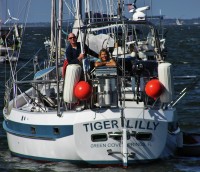
Who: Lilly and Tom Service
Port: Green Cove Springs



